What are adapters for pipes
Pipe adapters play an important role in virtually every piping system. At the same time, it doesn’t matter what purpose it is: external or internal sewage, external or internal water supply. If it is necessary to connect products, their use is often simply inevitable. Today there are a large number of technologies and, as a result, many materials from which adapters are made, for example, cast iron, PVC plastic, polypropylene, steel, and the like. To begin, consider some of the features of adapters.
Adapter Features
There are two types of adapters: concentric and eccentric.
- Concentric - used for vertical pipeline.
- Eccentric - used for horizontal pipelines.

As a rule, these types of adapters are used in plumbing, in industrial plants for the extraction of gas, oil, chemical plants. As mentioned above, adapters are made of different materials, for example, steel or polypropylene, PVC is also used. As for steel, the manufacture of metal adapters is made of its different types. For example, adapters for medium-aggressive and low-aggressive media (oil products, gas, etc.) are made from carbon steel.
If the intended medium will have increased aggressiveness, then alloyed or high-alloyed steel is used. This type of adapters has high technical characteristics, and the temperature of their working environment can be from -70 to +450 ° C, at a pressure of 15 MPa. However, it must be said that over the years, steel pipelines are out of use. They were replaced by polypropylene pipes, respectively, adapters are also made from the same material. Therefore, it is worthwhile to focus your attention on polypropylene adapters.
Adapters for polypropylene pipes
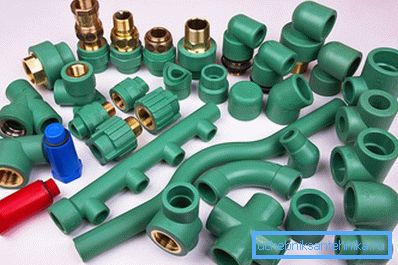
So, here are the main types of fittings for polypropylene pipes:
- couplings,
- adapters,
- corners,
- tees and crosses,
- contours,
- compensators.
Now consider the main features and scope of use of each type of fitting.
Clutch
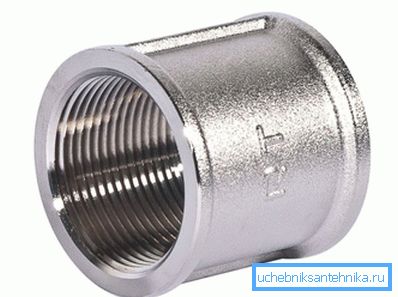
This type of fitting serves to connect two pipes of the same size. Has the shape of a keg. Its inner diameter is fully consistent with the outer diameter of the pipe used.
Adapters
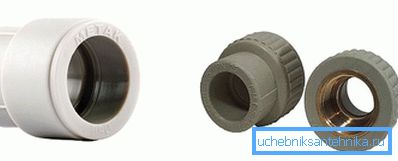
This adapter differs from the coupling in that there is a different internal diameter on the two sides of the barrel. Moreover, there are adapters for connecting polypropylene with metal through a thread. Such adapters are with external and internal thread.
Corners
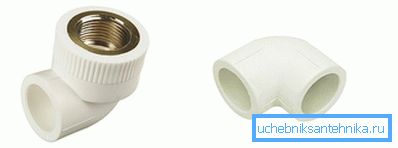
Although polypropylene pipes are bent, some changes in the structure occur at the site of the bend, due to which the throughput of the pipe is significantly reduced and the pipe wall becomes thinner on the outside. For this reason, there is a need for special corners, the bending of which can be 45–90 ° С. Moreover, there are corners, where, on the one hand, there is a thread for connection with a mixer or other stop valves. Corners can have both internal and external threads.
Crosses and tees

Some piping systems require connecting several pipes in one place. For example, it is necessary to take the pipe away from the riser in two opposite directions. Just for these purposes there are special crosses or tees. It is worth noting that tees, like crosses, come in different diameters from one side or the other. Moreover, there are tees with internal and external threads on the metal.
Contours
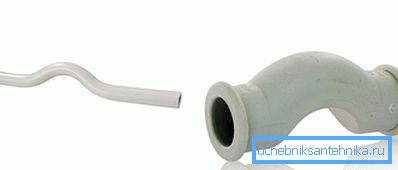
Some craftsmen, in order to save money, make similar contours from several tribes. However, from the technological point of view, this is not entirely practical, as the throughput decreases. Moreover, it is important to strive to ensure that there are as few joints and pipe joints as possible. That's why there are special contours that have a certain bend to circumvent the pipe around.
Compensators
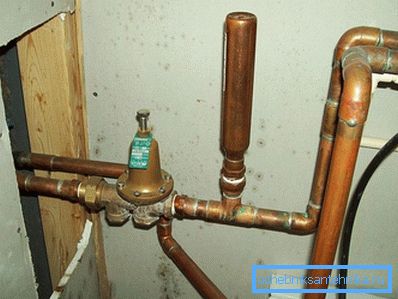
A compensator is a device that allows you to absorb various temperature drops, and as a result, powerful blows to the entire plumbing system. Although it has a simple form, its use will allow the pipeline to last longer.
American
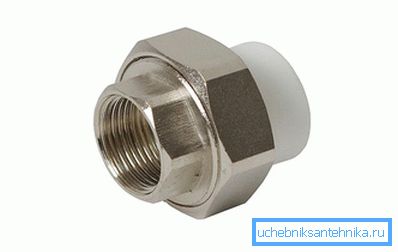
This is a special threaded connection that allows you to quickly disconnect and connect the trunk. It is used both in heating system, and in water. American nut can be used several times. To do this, simply replace the gasket. Unlike a clutch or locknut, its use is much more practical. Thanks to it, you can disconnect the line, while not rotating the pipe. It has found its wide application from the beginning of the use of polypropylene pipes, where on the one hand plastic, and, on the other hand, an American.
We discussed the types of adapters that are mostly used in the internal plumbing or heating system. Now we bring to your attention options for adapters that are used for the outdoor water supply system.
Types of compression adapters for outdoor water supply pipes PND
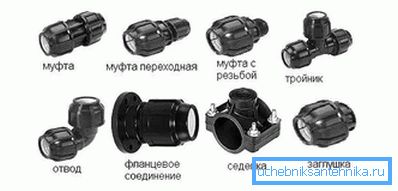
It is worth noting that the compression fittings are complete products. The conclusion from this follows: each element of a product can be interchangeable within one product group. This is true in cases where the replacement of an element is required. For example, a split ring is used for axial fixation. It is made of durable, but at the same time fragile polyamide. If the ring fails, the fitting should be disposed of or a ring made from a similar fitting. It is advisable, of course, to completely replace the fitting. Now consider the main types of compression couplings.
Clutch

These couplings are used to connect pipes of both the same diameter and different. Moreover, there are compression fittings with a transition to a metal thread. Make couplings with both internal and external thread.
Corner bend

Corner bends are used to change the direction of the pipeline. There are also bends with external and internal threads.
Tee
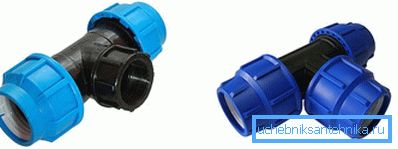
The tee serves for assignment of a plastic pipe to the side at 90 ° C. Such tees are produced, where there is a coupling on both sides, and on the other - an external or internal thread.
Saddle
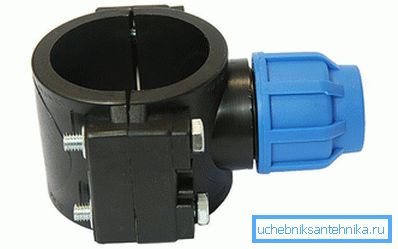
A nurse is an important part that consists of two halves that compress a pipe. Most often it is called a tie for a tie-in. If you need to crash into the highway, then this transition will allow you to quickly and reliably implement a tie-in to the system of technical or drinking water supply.
Transition with integrated ball valve

Such a fitting, combined with a ball valve, can be used after insertion into the trunk. Typically, such a transition is installed in the manhole, and after the pipeline is sent to the house.
Flange connection
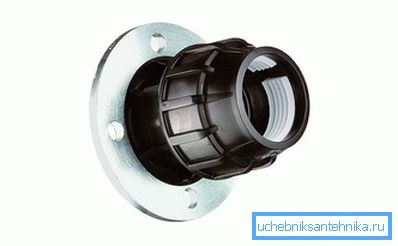
Flanged fittings help connect the HDPE polyethylene pipes with metal. The flange coupling has two main assemblies: the mounting flange and the compression flange. Compression allows to fix the pipe itself, and the mounting flange is connected by studs or bolts to the end of the metal flange. In this case, the size of the flange should be selected individually.
Cap

If for some time the line should be plugged, a plug is installed at the end of the pipe. It is much more profitable than buying a ball valve, especially if the pipe is temporarily silenced.
So, we have considered the main types of transitions that are used for outdoor water supply. Now it's the turn of the sewer system.
Transitions for the connection of iron and plastic in the sewer system
In the process of installing a sewer system, it is often necessary to connect pipes of different materials, for example, plastic and cast iron. To do this effectively, you should purchase special transitions that will allow you to quickly and simply connect such nodes. To do this, use a special rubber cuff, which may differ in its design: are for internal and external transition.
Internal rubber transition
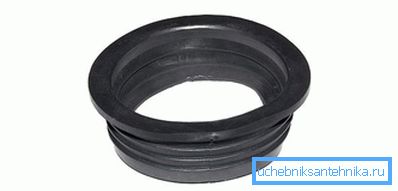
As a rule, it is inserted into the socket of a cast-iron pipe, which allows you to mount a plastic pipe of the desired diameter. The cross section of the outer part of the cuff is fully consistent with the diameter of the iron socket. Due to the special form there is no need to use a sealant, since the resulting compound is quite dense.
External plastic adapter (bottle)
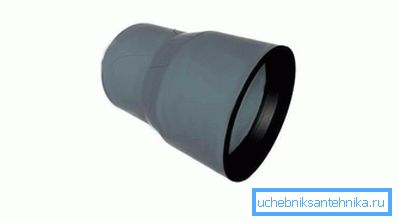
If the sewer line does not have a socket, then an external plastic adapter allows connection. Already after you can continue to lay the sewer system of plastic.
Types of transitions for external and internal sewage of plastic
Fittings are widely used to connect sewer pipes to each other. At the same time, they are divided into two types:
- Fittings for domestic sewage.
- Fittings for outdoor sewage.
They also have differences in the method of connection:
- Welded. This type of fitting has no rubber gaskets and threaded. They are connected using specialized welding machines.
- Glued. Similarly, as well as welded, they have no thread and rubber gaskets. With the help of special glue is docked in the ends.
- Threaded As a rule, they are used on drain pipes that have a small diameter, for example, under the sink.
- Rubber ring. This connection allows to achieve high tightness, so it is widely used in various types of sewer systems.
So, there are a number of transitions for the installation of both internal and external sewage systems:
- coupling,
- reduction,
- revision with cover,
- the crosspiece is two-plane,
- single-plane cross,
- tap,
- tee,
- triple tee tee 90 °,
- compensation pipe,
- stub
- check valve,
- two-piece siphon.
Now for each adapter more.
Coupling

The clutch is different in appearance, namely with emphasis and full bore. It is convenient to use them in places where it is required to connect two pipes without a bell. It is applied both to the external, and internal sewerage. There are differences in color.
Reduction
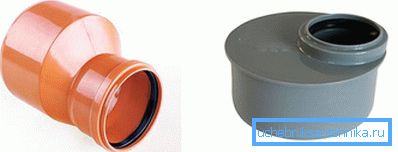
This transition allows you to connect pipes of different diameters. Moreover, this transition allows you to switch from cast iron to plastic pipe.
Tip! It is recommended to move only from the larger to the smaller diameter. This will prevent blockages.
Cover Revision

As for the audit for internal sewage, it is used to penetrate the pipe and, if necessary, to eliminate the blockage that has occurred. The audit is installed on the main riser. As for the external sewage system, the revision can be mounted in the manhole. As a rule, you should install an audit of a larger diameter. It also plays a key role in the cleaning process of the pipeline system.
Crosspiece two-plane

This adapter has crosses in different planes. As a rule, it is used in nodal joints of sewer pipes. At the same time, several pipes can be connected simultaneously and pipes of different diameters. Such places are considered extremely difficult. If they are not used, the nodular ligament will have a large number of joints, and this may lead to leakage. The two-plane crosspiece is a successful solution, since its whole construction is monolithic. Moreover, some crosses can have a bell angle of 45–90 °.
Cross single plank

All sockets of such an adapter are located in the same plane. It also as well as two-plane is used in nodal joints of pipes. Moreover, there are crosspieces with sockets of different diameters and at different angles - 45–90 °.
Tap
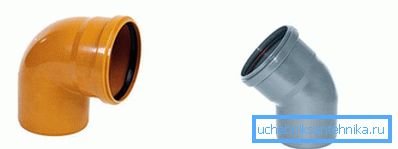
In each sewer system this type of drainage is very important. It allows you to change the direction of the highway. It has different angles of rotation: 30 °, 45 °, 90 ° and not only. Thanks to them, a drop and a vertical angle are created, as a result, the drains get into the septic tank much faster.
Triple tee 90 °

Here we can distinguish two types of tee. The first is a simple tee that allows you to connect a vertical and horizontal sewer pipe. When this tees are made with different angles, for example, 45 °, 67 °, 90 °. The second type is a 90 ° three-socket tee. It allows you to make similar connections, only with a pipe of a different diameter.
Compensation nipple
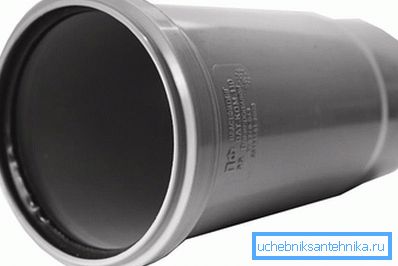
In most cases, this adapter is used in the internal sewer system. It is used for removal of liquid household waste in a septic tank.
Cap

The cap has found its application in places where it is necessary to close the sewer pipe, thereby preventing the flow of fluid. Sometimes the cap can be tightly closed, and in some cases leave a gap, so that there is an opportunity to clean the pipe. As a rule, it is fixed on the rubber seal.
Double siphon
It is used in all sewer systems for outdoor use. Especially in those places where there is a site of the sewage receiver. It prevents the formation of gases. In some cases, a two-piece siphon can be used in pipeline ventilation systems.
Check valve
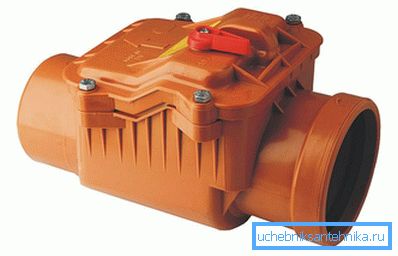
If the sewer pipe is installed at a slight inclination, the non-return valve will prevent the flow of effluent in the opposite direction.
So, we have listed the most widespread transitions to pipes both water, and sewer. Although, most likely, on the shelves of the store you can find other types of adapters. In this case, the most important thing is to understand their purpose. Moreover, just before the purchase itself, it is best to draw up a diagram of one or another communication system, this will allow you not to buy unnecessary transitions to pipes, respectively, save your money!